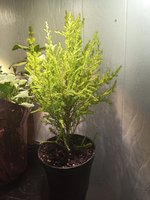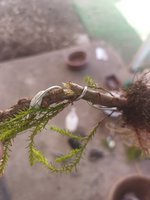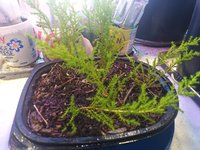You are using an out of date browser. It may not display this or other websites correctly.
You should upgrade or use an alternative browser.
You should upgrade or use an alternative browser.
Suggest an indoor evergreen or conifer to stay under lights
- Thread starter ShadyStump
- Start date
ShadyStump
Imperial Masterpiece
For several weeks now my shelf has been hosting an herb garden of sorts.

Potted sage, rosemary and thyme, on clearance after the holidays. Not in the best shape when I got them.
The rosemary hasn't done much, but is healthier, and the sage and thyme have taken off.
This shows me that my set up is conducive to meeting the needs of somewhat light greedy plants, and that the heater vent situation has been successfully mitigated.
This discount lemon cypress is on the block for attempt number two, unless I change my mind in keeping with my recent posts on flowering subtropicals.


Potted sage, rosemary and thyme, on clearance after the holidays. Not in the best shape when I got them.
The rosemary hasn't done much, but is healthier, and the sage and thyme have taken off.
This shows me that my set up is conducive to meeting the needs of somewhat light greedy plants, and that the heater vent situation has been successfully mitigated.
This discount lemon cypress is on the block for attempt number two, unless I change my mind in keeping with my recent posts on flowering subtropicals.

ShadyStump
Imperial Masterpiece
So I think it's about that time for this 99 cent lemon cypress to go in a real pot if I'm to continue this experiment.
The good news there is a have access to even better lighting now, though I'm inclined to take it slower on this go around and keep it mainly in my living room window where it's been happy since I got it.
I have no experience with these. Any suggestions or tips? In my mind it seems like I should go about it much the same as a juniper, but then what do I really know? I'm the nut trying to keep a conifer indoors.
The good news there is a have access to even better lighting now, though I'm inclined to take it slower on this go around and keep it mainly in my living room window where it's been happy since I got it.
I have no experience with these. Any suggestions or tips? In my mind it seems like I should go about it much the same as a juniper, but then what do I really know? I'm the nut trying to keep a conifer indoors.
ShadyStump
Imperial Masterpiece
Also, this is the plan now. I might have the means to something more permanently indoors someday, but now is not that day.@ShadyStump -- just a thought (without experience to back it) -- if/when light is the only issue to manage, could you rotate several trees, so that they all stay healthy while you still get to enjoy each on the shelf for a couple of days?
ShadyStump
Imperial Masterpiece
Crazy Diamond
Omono
I feel your pain bro haha we all been thereWell THAT learning curve didn't go in the intended direction.
View attachment 422148
Guess I'm learning how to propagate in stead.
View attachment 422149
I put the stump with roots back in the original pot.
View attachment 422150
Dipped and stuck 5 branches.
ShadyStump
Imperial Masterpiece
I'm sure it won't be the last time.I feel your pain bro haha we all been there
HorseloverFat
Squarepants with Conkers
I believe your wire coils were not poised to take/distribute the pressure correctly AROUND and through the curve.

Takes a lot of "doin".. to even do it half-assed....
Things start "clickin" though.

Takes a lot of "doin".. to even do it half-assed....
Things start "clickin" though.
ShadyStump
Imperial Masterpiece
I was proud of myself for the neatness of my wiring, but you're right. There's more to it than that.I believe your wire coils were not poised to take/distribute the pressure correctly AROUND and through the curve.
Takes a lot of "doin".. to even do it half-assed....
Things start "clickin" though.

It was also my ignorance of the qualities of the wood. It apparently goes from soft and pliable to hard and brittle in a short distance.
HorseloverFat
Squarepants with Conkers
Twas neat!...I was proud of myself for the neatness of my wiring, but you're right. There's more to it than that.
It was also my ignorance of the qualities of the wood. It apparently goes from soft and pliable to hard and brittle in a short distance.
I, personally, to avoid similar mistakes I've made in the past, would've lined up my coils to support that bend, more coils at a "gentler" angle. Possibly (If necessary) lay another wire, in the center of the negative space left by the first wire... for a tad extra support. Because that wood (the very wood you JUST described).. gives little-to-no warning before.. um.. y'know..
Question..
Were you wiring whilst OUT of the pot?... or was that for the sake of the picture?
ShadyStump
Imperial Masterpiece
I originally had not intended to wire it at all that low, but (yes, wiring whilst out of the pot) I found more trunk than expected under the soil level, and was attempting to adjust the design, and got ahead of myself.Twas neat!...
I, personally, to avoid similar mistakes I've made in the past, would've lined up my coils to support that bend, more coils at a "gentler" angle. Possibly (If necessary) lay another wire, in the center of the negative space left by the first wire... for a tad extra support. Because that wood (the very wood you JUST described).. gives little-to-no warning before.. um.. y'know..
Question..
Were you wiring whilst OUT of the pot?... or was that for the sake of the picture?
Leo in N E Illinois
The Professor
- Messages
- 11,339
- Reaction score
- 23,284
- USDA Zone
- 5b
@ShadyStump - your wiring looked neat, the problem was - the wire should be on the outside of the bend. OR you bend the trunk or branch at the point where the wire would be on the outside of the curve. That way the wire supports the branch or trunk. If the wire is on the inside of the curve, the branch or trunk can kink, resulting in a break. It is quite difficult to plan your wire to have the wire land on the outside of the curves. With young material, often I place the curves in the branch or trunk based on where the wire lands, bend the trunk so that the wire is the outside of curves. For more mature branches and trunks, you may have to wire, and then remove and re-wire several times to get the placement correct BEFORE applying pressure to bend.
So remember, wire on the OUTSIDE of the bend.
Nobody told me this until I had been doing it wrong for a couple decades. Colin Lewis has several really good tutorials on line and in his books on wiring. I finally learned to wire from Colin, in person when our club brought him to Milwaukee. AdairM in a number of posts explains wiring technique well, as does RockM and a few others. CHeck the Tutorial section of BNut.
So remember, wire on the OUTSIDE of the bend.
Nobody told me this until I had been doing it wrong for a couple decades. Colin Lewis has several really good tutorials on line and in his books on wiring. I finally learned to wire from Colin, in person when our club brought him to Milwaukee. AdairM in a number of posts explains wiring technique well, as does RockM and a few others. CHeck the Tutorial section of BNut.
ShadyStump
Imperial Masterpiece
I'll remember that, and do some reading. Thanks!@ShadyStump - your wiring looked neat, the problem was - the wire should be on the outside of the bend. OR you bend the trunk or branch at the point where the wire would be on the outside of the curve. That way the wire supports the branch or trunk. If the wire is on the inside of the curve, the branch or trunk can kink, resulting in a break. It is quite difficult to plan your wire to have the wire land on the outside of the curves. With young material, often I place the curves in the branch or trunk based on where the wire lands, bend the trunk so that the wire is the outside of curves. For more mature branches and trunks, you may have to wire, and then remove and re-wire several times to get the placement correct BEFORE applying pressure to bend.
So remember, wire on the OUTSIDE of the bend.
Nobody told me this until I had been doing it wrong for a couple decades. Colin Lewis has several really good tutorials on line and in his books on wiring. I finally learned to wire from Colin, in person when our club brought him to Milwaukee. AdairM in a number of posts explains wiring technique well, as does RockM and a few others. CHeck the Tutorial section of BNut.
We'll have to see what else I find to continue this experiment. In another month it may be safe to move my tropicals and such outside, and I'll be working through repotting as they do. Im hoping to have several gardenias to work with out of the pot I got last month- looks to be a collection of cuttings. May try cycling those through, may find something else.
HorseloverFat
Squarepants with Conkers
Leo, you were the first one to tell ME this info, also!@ShadyStump - your wiring looked neat, the problem was - the wire should be on the outside of the bend. OR you bend the trunk or branch at the point where the wire would be on the outside of the curve. That way the wire supports the branch or trunk. If the wire is on the inside of the curve, the branch or trunk can kink, resulting in a break. It is quite difficult to plan your wire to have the wire land on the outside of the curves. With young material, often I place the curves in the branch or trunk based on where the wire lands, bend the trunk so that the wire is the outside of curves. For more mature branches and trunks, you may have to wire, and then remove and re-wire several times to get the placement correct BEFORE applying pressure to bend.
So remember, wire on the OUTSIDE of the bend.
HorseloverFat
Squarepants with Conkers
ShadyStump
Imperial Masterpiece
Yeah, yeah, I know.
There was some screen sort of thing around the base that the roots were growing through. I was trying to get that off, and it took a chunk of the root with it. Not enough big roots left to reasonably wire it into the pot, so I figure wire it really quick then pot it up.
HorseloverFat
Squarepants with Conkers
I would be worried (If tree was out of pot and NOT clamped) about overcompensating my adverse-pressure/support... and snapping the trunk...Yeah, yeah, I know.
There was some screen sort of thing around the base that the roots were growing through. I was trying to get that off, and it took a chunk of the root with it. Not enough big roots left to reasonably wire it into the pot, so I figure wire it really quick then pot it up.
No matter HOW my wire was.. this would be a personal concern of mine...
It seems like the tree and wire aren't the issue with bare-root wiring like that... they KNOW what to do..
It's that ...counter-"support" issue, I believe. That makes this process, to me, a bit... sketchy.
Like a guy in a bowler's cap and a trenchcoat....
"Hey Kid! Want a cigarette?"
Obviously... the parameters outlined above by Leo regarding coils/stress/wiring... is an ESSENTIAL piece of information.. and will yield success in ALL applications.
I just wanted to touch on that "bare-root wiring" a tad..
ShadyStump
Imperial Masterpiece
I really think I was just rushing because it was out of the pot and bare rooted, and I applied too much pressure to fast. I wasn't certain how these did with bare rooting, but I had to get that screen stuff off, and I was going too fast.I would be worried (If tree was out of pot and NOT clamped) about overcompensating my adverse-pressure/support... and snapping the trunk...
No matter HOW my wire was.. this would be a personal concern of mine...
It seems like the tree and wire aren't the issue with bare-root wiring like that... they KNOW what to do..
It's that ...counter-"support" issue, I believe. That makes this process, to me, a bit... sketchy.
Like a guy in a bowler's cap and a trenchcoat....
"Hey Kid! Want a cigarette?"
Obviously... the parameters outlined above by Leo regarding coils/stress/wiring... is an ESSENTIAL piece of information.. and will yield success in ALL applications.
I just wanted to touch on that "bare-root wiring" a tad..
Normally I would make slight bends slowly, moving up and down the trunk several times, adjusting the bend a little at a time. Not this go'round. Another lesson in patience.
Leo in N E Illinois
The Professor
- Messages
- 11,339
- Reaction score
- 23,284
- USDA Zone
- 5b
I did not pay attention to the fact that the wiring was done while bare root. I won't say I never did that myself, but speed is the issue anytime you bare root a tree.
In the future, try to work with the wiring while the roots are either in a pot, with moist media, or wrapped in a damp towel or moist sphagnum or something to keep the roots moist. Your get better leverage while wiring if the tree is securely potted up.
But there have been occasions, especially with seedings, where they are being repotted, and a piece of wire is being slapped on them as they go from the seedling flat to the next container.
Not the recommended treatment, but not unheard of.
In the future, try to work with the wiring while the roots are either in a pot, with moist media, or wrapped in a damp towel or moist sphagnum or something to keep the roots moist. Your get better leverage while wiring if the tree is securely potted up.
But there have been occasions, especially with seedings, where they are being repotted, and a piece of wire is being slapped on them as they go from the seedling flat to the next container.
Not the recommended treatment, but not unheard of.
ShadyStump
Imperial Masterpiece
Yeah, wasn't part of the plan to do it that way, but an effective learning experience nonetheless.I did not pay attention to the fact that the wiring was done while bare root. I won't say I never did that myself, but speed is the issue anytime you bare root a tree.
In the future, try to work with the wiring while the roots are either in a pot, with moist media, or wrapped in a damp towel or moist sphagnum or something to keep the roots moist. Your get better leverage while wiring if the tree is securely potted up.
But there have been occasions, especially with seedings, where they are being repotted, and a piece of wire is being slapped on them as they go from the seedling flat to the next container.
Not the recommended treatment, but not unheard of.
Pulled it from the nursery pot thinking to wire it straight into the new pot, but there was less root than I expected, and that damned mesh around them. So little larger root that I couldn't even effectively wire it in, so I went with wiring the trunk then pot it. Didn't work.
Similar threads
- Replies
- 2
- Views
- 178
- Replies
- 9
- Views
- 343
- Replies
- 13
- Views
- 3K




